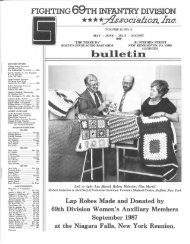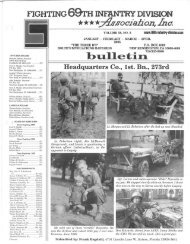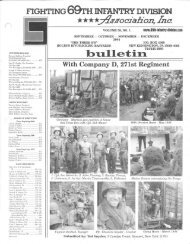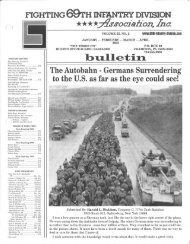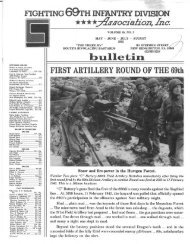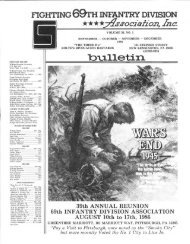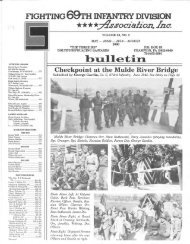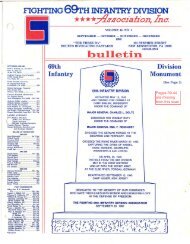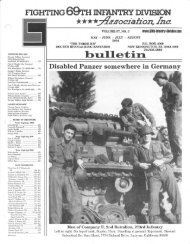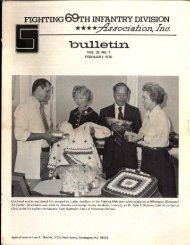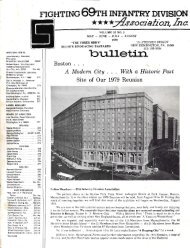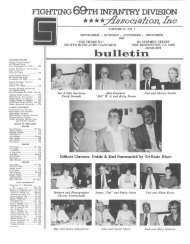The Fighting 69th Infantry Division Association, Inc. Vol. 50 No. 2 ...
The Fighting 69th Infantry Division Association, Inc. Vol. 50 No. 2 ...
The Fighting 69th Infantry Division Association, Inc. Vol. 50 No. 2 ...
Create successful ePaper yourself
Turn your PDF publications into a flip-book with our unique Google optimized e-Paper software.
<strong>The</strong> <strong>69th</strong> Counter<br />
Intelligence Corps<br />
Submitted By: Ellis M. Benson<br />
<strong>69th</strong> CIC Detachment<br />
426 East Fulvia Street<br />
Leucadia, California 92024-2145<br />
<strong>The</strong> <strong>69th</strong> Counter Intelligence Corps detachment<br />
was activated 23 September 1944 at Camp Shelby,<br />
Mississippi and traveled with this <strong>Division</strong> overseas.<br />
<strong>The</strong> original strength of seven was increased to seventeen<br />
upon arrival in England, the additional men<br />
being selected from the <strong>Division</strong>.<br />
Having graduated from the University of California<br />
at Berkeley in Dec. 1941 with a major in history and a<br />
minor in German, I was sent to the Air Force where I<br />
had a short stint from which I was transferred to the<br />
Army Specialized Training Program to learn Italian<br />
by the total immersion method back at the University<br />
of California at Berkeley. After nine months of this<br />
training and having achieved fluency in the language,<br />
the army, being what it is, shipped me to the <strong>69th</strong><br />
Combat Engineers at Camp Shelby and I went overseas<br />
with that unit.<br />
Upon arrival in England the call went out for men<br />
with language and other capabilities. I was selected by<br />
the <strong>69th</strong> CIC (Counter Intelligence Corps) and identified<br />
as a Special Agent. <strong>The</strong> unit was quartered in the<br />
Winchester School where the new men began training<br />
in investigative and interviewing techniques.<br />
A large amount of equipment was gathered to<br />
include fingerprint material. We<br />
were issued 45 pistols as well as<br />
snub nose 38's to use as concealed<br />
weapons. Also issued were Khaki<br />
trench coats. Instead of rank<br />
insignia we wore the U.S. symbols<br />
on each collar of the shirt as<br />
well as on the military cap, and<br />
were addressed as Mister. We<br />
were issued carbines for use in<br />
several jeeps which were allocated<br />
to the detachment.<br />
<strong>The</strong> Detachment crossed the<br />
Channel with the <strong>Division</strong> from<br />
Southhampton to LeHavre in<br />
January 1945 and was housed in<br />
the King George V Hotel in Paris<br />
directly after its liberation. We<br />
moved with the <strong>Division</strong> through<br />
France and Belgium going from<br />
town to town interviewing the<br />
mayors seeking French collaborators<br />
or rexistes as the Belgian<br />
Nazi collaborators were known.<br />
-16-<br />
Our task basically was to remove the risk of such collaborators<br />
as the <strong>Division</strong> moved.<br />
As the Siegfried Line was breached and we entered<br />
Germany the task of identifying Nazi leaders as well<br />
as fanatic individuals who might pose a threat to our<br />
troops became all engrossing.<br />
A questionnaire (Fragebogen) was developed which<br />
was administered to each suspect. Generally the<br />
German people in the Nazi period and even prior to<br />
that, were taught in their culture to respect authority.<br />
<strong>The</strong>refore they tended to respond truthfully to the<br />
questions. It was indeed rare to find anyone who had<br />
not been a member of the party or at least one of its<br />
affiliate organizations. For example teachers were<br />
told in 1937 to join the party or lose their jobs.<br />
<strong>The</strong> number of affiliate organizations was large to<br />
the extent that almost anyone could find one which<br />
had some interest for them, for example the party sailing<br />
club, sports club, skiing club and so on.<br />
Of course. teenage children were mandated to join<br />
the Hitler Youth (Hitler Jugend). Or for the younger<br />
ones, the girl's club Bund Deutche Madel. Mature<br />
women were brought together in the Frauenschaft.<br />
Teachers were joined in the Bund Deutsche Lehrer.<br />
Many professors and vocations were brought together<br />
under the party aegis.<br />
<strong>The</strong> CIC task was to follow leads in each town expecting<br />
to find those who might pose a threat. <strong>The</strong> top<br />
expectation of course was to find one of the upper leadership<br />
Nazis. At most our detachment did capture<br />
leaders of the Gau (state) level and mostly at the<br />
(Continued on Page 17)



